10,000 Subscribers
Hitting a meaningful milestone, I'm taking a brief break from my vacation to express my gratitude to all of you and share one of my favorite Royals Extra features
Since my last post, I have been savoring an extended reunion with family including an art workshop for four of my five grandchildren, all aspiring to be the next Matisse. But I couldn’t resist pausing when I noticed that I had passed the 10,000-subscriber mark for Royals Extra. Thank all of you so very much for being part of the Royals Extra community, especially my paid subscribers who can read the full versions of my articles and have access to more than 100 Royals Extra posts over the last 18 months.
I am re-posting below in its entirety a feature I wrote last December 22 about the late Queen Elizabeth II’s friendship over many decades with Lord Carnarvon, known as “Porchey.” It is one of my favorite Royals Extra articles, not least because I could include private photographs given to me by Sir Michael Oswald, the manager of the Queen’s Sandringham Stud, about whom I wrote on October 14, 2023. (16) Inside the Royal Stud at Sandringham (substack.com)
I also want to pay tribute to Lord Fellowes, Lord Carnarvon’s eulogist at his funeral in 2001. Robert Fellowes, who served the Queen as a senior adviser for twenty-two years, died peacefully in Norfolk near Sandringham on July 29 at age 82. The late Diana, Princess of Wales, was the younger sister of his widow, Lady Jane Fellowes. He was a man of impressive accomplishments and interests, contrary to the public perception of him as a stuffy traditional courtier. His brother-in-law, Earl Spencer, praised his “humour, wisdom, and utter integrity.” Lord Fellowes provided a steady hand during the turbulent end of Charles and Diana’s marriage culminating in her traumatic death in a car crash in 1997. In the months ahead, I’ll be writing more in Royals Extra about the Queen and Lord Fellowes as well as Lord and Lady Carnarvon.
With all my best,
Sally Bedell Smith
In its final season, The Crown returns to the Queen's friendship with "Porchey," her racing manager for thirty years
They spent happy "working holidays" in Kentucky's Bluegrass Country, captured in photographs I am sharing for the first time
Sally Bedell Smith
Dec 22, 2023
As viewers wend their way through the sixth and last season of The Crown, they are being reintroduced to Henry George Reginald Molyneux Herbert, the 7th Earl of Carnarvon, who turned up in the first three seasons. In each of those instances, the series implied that the Queen and her longtime friend— nicknamed “Porchey” after the Lord Porchester title he held until he inherited the earldom in 1987—were having an affair.
While that innuendo had no basis in reality, The Crown’s creators spun it into various invented scenes, imagining that Porchey made Prince Philip jealous. In one plotline, the Queen and Porchey visited Kentucky together for several weeks to explore new breeding techniques for her stable of thoroughbreds. They were depicted as savoring their horse racing bond a tad too closely until their idyll was interrupted by the Queen’s summons back to Britain on urgent business. “Somehow today has managed to be one of the most enjoyable days of my life, and at the same time, one of the most depressing,” Olivia Colman as the Queen told John Hollingworth as Porchey. The Crown has Colman implausibly explaining the reason for her sadness: she had been experiencing her “unlived life” of quietly breeding, training, and racing horses with a like-minded man rather than fulfilling her duties as monarch.
Fact and fiction commingle
In the sixth and final season released on December 14th, Porchey appears with then-Princess Elizabeth in a flashback to VE-Day in 1945, and in 2001, the Queen tells her ailing sister, Princess Margaret, that Porchey has died of a heart attack while watching the news of the 9/11 terrorist attack. As with much of The Crown, fact and fiction commingle: The Crown shrinks the group of sixteen on VE-Day to four and has Elizabeth dancing wildly at the Ritz instead of snaking quickly through the hotel as part of a conga line. Porchey did in fact die as recounted in The Crown.
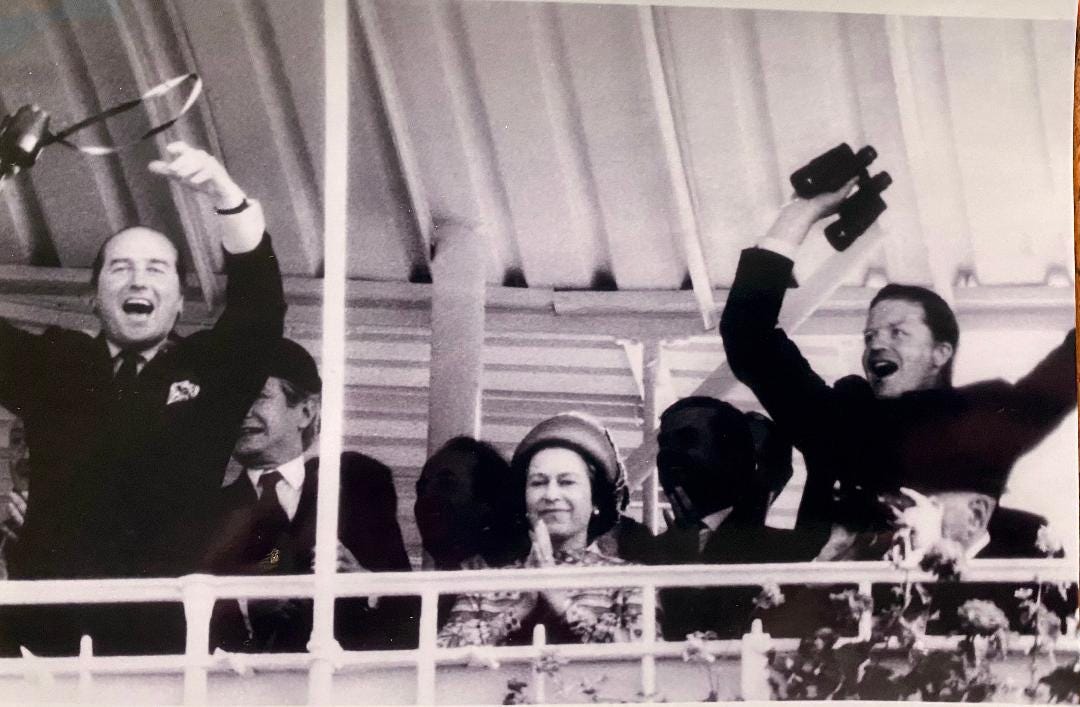
In researching my biography, Elizabeth the Queen: The Life of a Modern Monarch, I steeped myself in her life as a thoroughbred owner and spoke to many people in the horseracing world. Given the depiction of Porchey in The Crown, it’s worth clarifying the Queen’s relationship with him—and equally with his wife Jeanie, who I interviewed at some length. One of the most fascinating aspects of this friendship was the surprisingly strong connection to the United States, including five visits to Kentucky—in 1984, 1986, 1989, 1991, and 2007. They were the only private vacations Elizabeth II took outside her own estates in England and Scotland during her seventy-year reign. The first four of those visits were closely managed by Porchey.
Porchey’s mother was a New Yorker named Catherine Wendell. The former Jean Wallop grew up in Wyoming; her paternal grandfather, the 8th Earl of Portsmouth, had married the daughter of a Kentucky judge and settled in the American West. Henry Porchester and Jean Wallop were introduced in 1955 by her first cousin Micky Nevill (a friend since childhood of Queen Elizabeth II), also an Anglo-American: “My proudest accomplishment,” Micky told me. Porchey and Jeanie married in 1956 and quickly became part of the exclusive social set around the Queen and Prince Philip.
Kentucky entered the picture after the Queen appointed Porchey—a friend since they were teenagers in the 1940s—as her first racing manager in 1970. She also named Sir Michael Oswald as the manager of the Royal Stud on her Sandringham estate. She and her racing advisers knew that they could only make real progress by taking advantage of superior American breeding stock.
Bring in new blood
Porchey began sending Elizabeth II’s mares to Kentucky to mate with the world’s best stallions in an effort “to bring in new blood.” In 1984 they decided to arrange her first private “working holiday” in the Bluegrass state. The 58-year-old Queen would spend five days around Lexington visiting her mares at the top stud farms and inspecting more than sixty stallions for possible mating. Her hosts that autumn and for each of her subsequent trips were 45-year-old William Stamps Farish III and his wife Sarah at their 1,400-acre stud farm, Lane’s End, in Versailles (pronounced Ver-SALES) near Lexington.
Originally from Houston, Will had inherited a fortune from Humble Oil (later Exxon) and Sears Roebuck, and Sarah was a du Pont heiress. The Farishes had moved to Kentucky in 1963 and in the following decades had built a world-class thoroughbred operation with modern facilities including customized “elliptical” fences without corners that could injure the horses. The legendary horse breeder Paul Mellon, a close friend of the Queen, had introduced her to the Farishes, with the assurance that they would be congenial and discreet.
Although it was a private visit, the Queen’s itinerary was mapped out minute by minute by the British Embassy and Catherine “Bundles” Murdock, a State Department protocol officer who had grown up in Virginia’s horse racing community. Despite all the planning, the Queen nearly wasn’t admitted to the United States when her flight landed in a downpour at Lexington’s Blue Grass Field on October 7, 1984.
Because the Queen couldn’t produce a passport—as Sovereign, she didn’t have one--the local customs and immigration official said she could not let her in. It took a call to the State Department to provide the necessary clearance. At Lane’s End, “there was a posse of security,” recalled Michael Oswald’s wife Angela, who was serving as the monarch’s lady-in-waiting. “The Queen wanted to go for a walk, so she put on her brogues and raincoat and went off in the wet grass.”
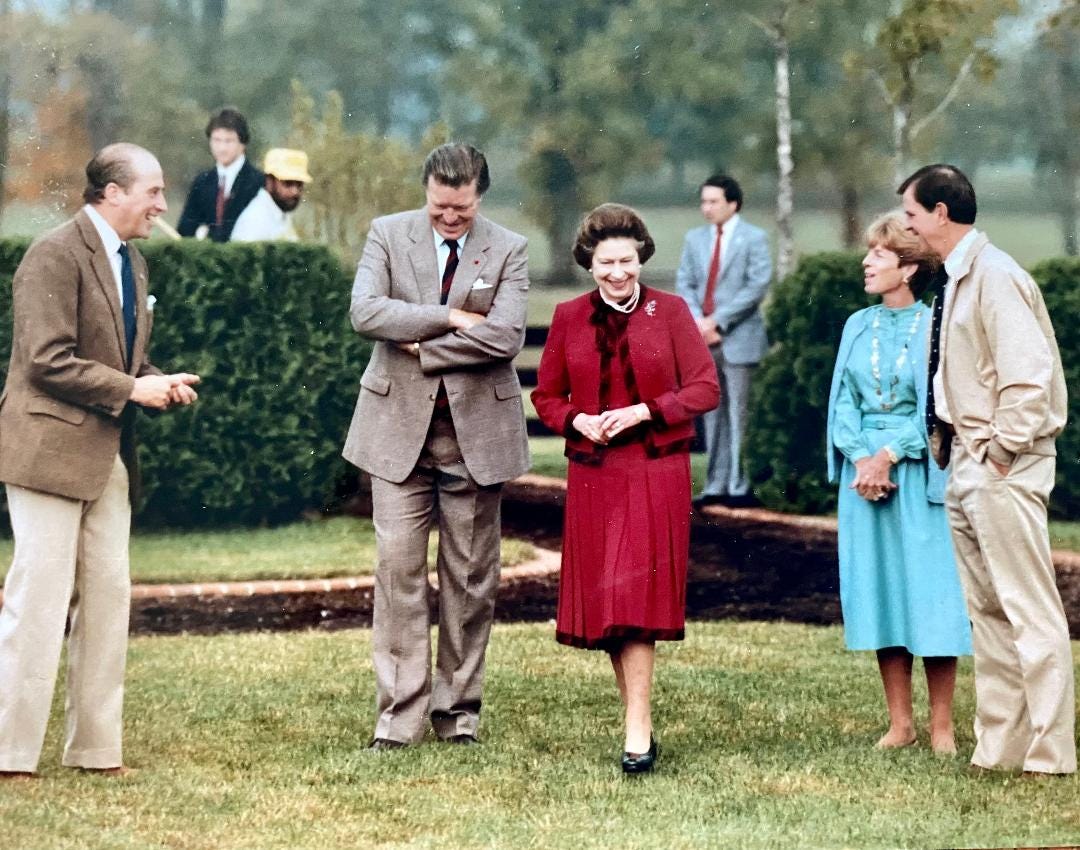
She was beyond professional
Over the next five days, the Queen and her retinue traveled in a caravan of cars to see the thoroughbreds she and Porchey had chosen to inspect. “The visit was one hundred per cent horses,” Catherine Murdock recalled. “The Secret Service agents driving her were so impressed by her knowledge. She and Lord Porchester and Will Farish would get into it about bloodlines. She was beyond professional.” The visits to the stallions were carefully staged: a stable boy would lead out the horse, while the trainer and breeder would give the Queen briefings.
Porchey’s wife Jeanie came along on that first trip and recalled when they were watching the horses, the Queen “was telling me how to listen to the way they put their hooves down. She was like a horse whisperer. She understood them.” As for Porchey, “he was very knowledgeable, and someone she could trust. He was her best friend. That is absolutely true.”
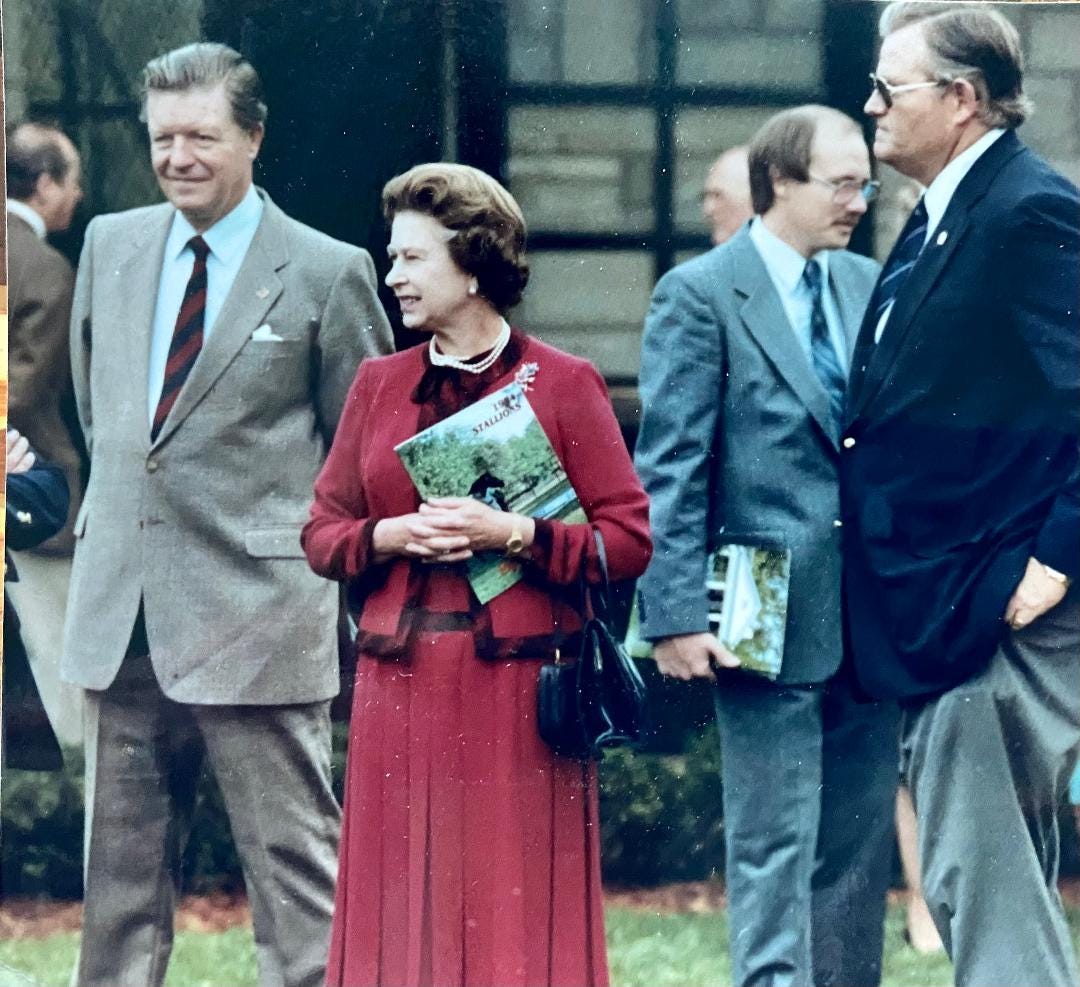
Informality and gaiety
Jeanie also noted that “one of the times I saw her most relaxed was in Kentucky with Kentucky racing people. She lit up. It was exciting for her to be in a different place.” The Farishes hosted dinner parties for ten every night. The Queen’s only request was that all the guests be “horse people.” One of her Palace advisers “saw an atmosphere of informality and gaiety that I never saw in England…She was laughing and joking and having fun.”
The Queen’s later visits ran along the same lines. In 1986 she met her first Kentucky foal, a filly born to her mare Christchurch, with Alydar, a champion stallion, as the sire. Unlike her previous visit, when she attended the races at Keeneland, inspected the Bloodstock Research Information Services, and witnessed a mock auction, her only public appearance was when she attended a service at St. John’s Episcopal Church.
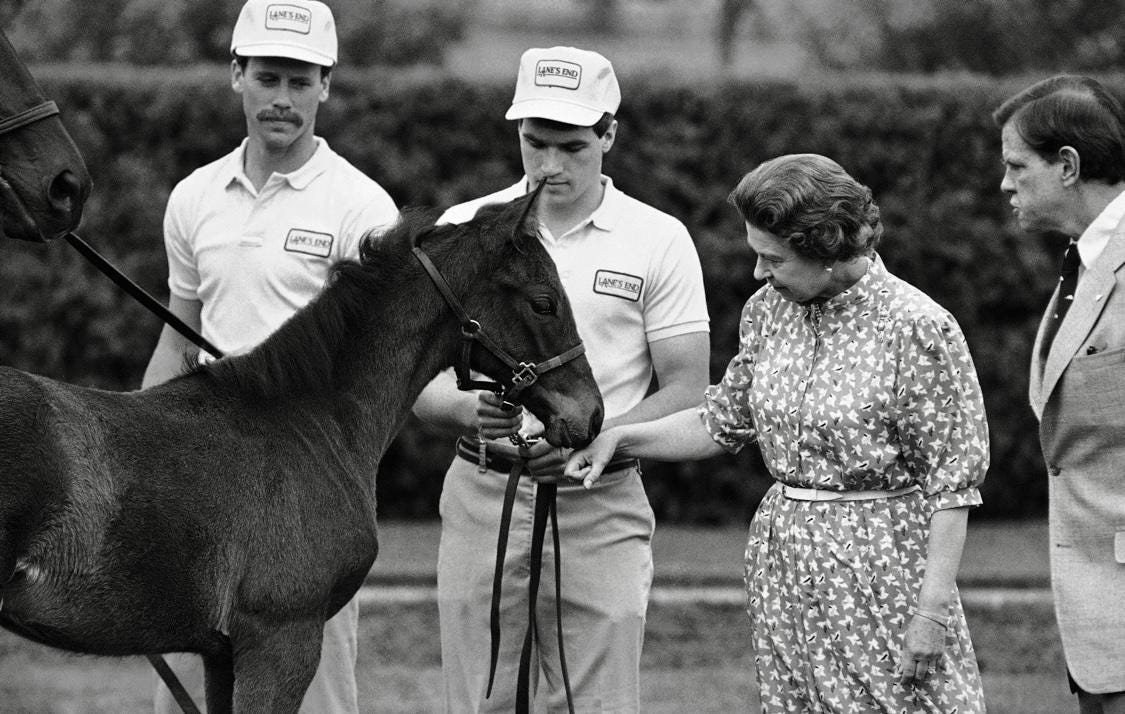
In late May three years later, she and Porchey and Michael Oswald saw another foal, only a month old, at Lane’s End. She also had an opportunity to cuddle with one of the Farishes’ dogs. And at the Shadwell Stud owned by Hamdan Al Maktoum of the Dubai royal family, she visited Height of Fashion, a mare she had sold to the sheikh for more than £1 million in 1982.
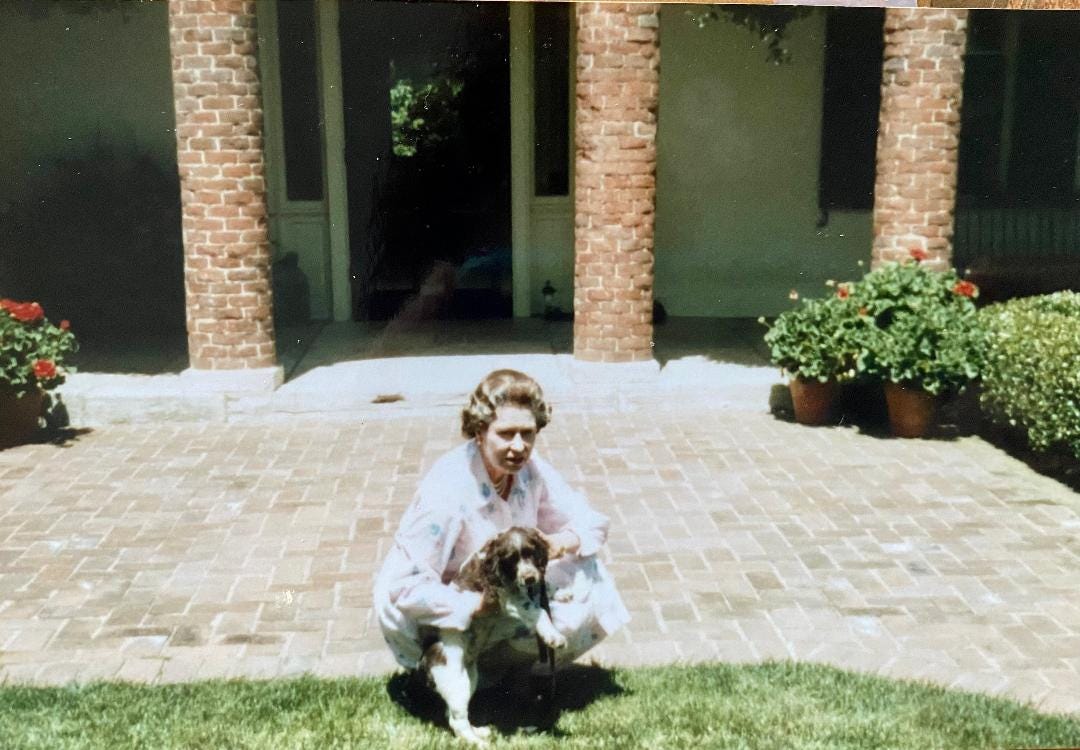
The Queen made a marathon nine-day tour of the United States in May 1991 that culminated in a state visit hosted by President George H.W. Bush and First Lady Barbara Bush. The Queen squeezed in a final weekend with the Farishes at Lane’s End, where she was greeted by Sarah with an affectionate kiss on the cheek. She visited the stallions as usual, but Will Farish said that her stay was “a real vacation for her” after all her official activities.
The visits to Kentucky ceased after that, as the breeding center of gravity shifted to the Republic of Ireland, where the Coolmore and other powerhouse studs had hundreds of superior stallions. After the Good Friday Agreement brought peace to Northern Ireland in 1998, the Queen could send her mares across the Irish Sea.
He gave life the full treatment
Three years later, on September 11, 2001, Porchey and Jeanie were watching television as terrorists attacked the World Trade Center in Manhattan. After a hijacked plane hit the second tower, “I left the room to go get a fax,” she told me. “When I came back, Porchey had collapsed.” She said that for several days he had been experiencing back pain “which we later learned is a symptom of an aorta going wrong.” He had suffered from a burst aorta, which is invariably fatal. In the ambulance on the way to the hospital, Porchey said to Jeanie, “Would you call the Queen?” She did, and he later died at age 77 in the operating room.
Porchey’s funeral was at St. Michael and All Angels in Highclere, and the Queen and Prince Philip attended, which was unusual. In his eulogy, Lord Fellowes, the Queen’s former private secretary and a friend of Porchey’s for many years, described him as “a happy man who laughed a lot…He gave life the full treatment, whether he be at work or play.” The Queen “was as stoic as ever,” Jeanie told me. “Were there tears?” I asked. “I think so,” Jeanie replied.
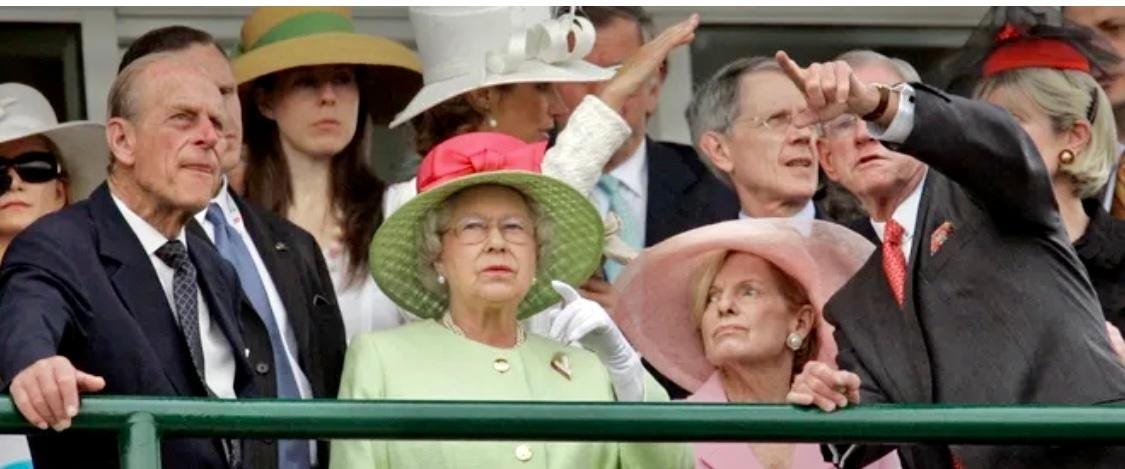
The Queen, this time accompanied by Prince Philip, visited the Farishes in Kentucky once more in 2007. Their main objective was to fulfill a lifelong dream and see the Kentucky Derby for the first time. The legendary race offered the sort of excitement that would have thrilled Porchey, with a stunning win by Street Sense, ridden by Calvin Borel. In Washington two days later, President George W. Bush and First Lady Laura Bush hosted the Queen for a state visit. Laura Bush invited Calvin Borel to attend the State Dinner and arranged to have him outfitted in white tie. As the Queen posed with the First Lady and Borel for a photograph, the jockey from Louisiana’s Cajun country wrapped his arms around both women—a cheeky gesture that doubtless would have amused Porchey.

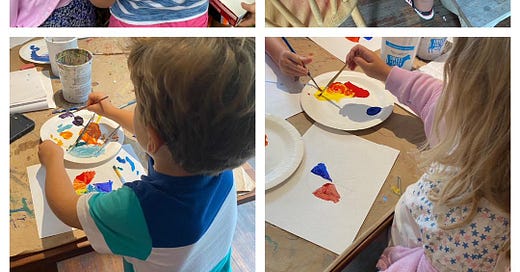



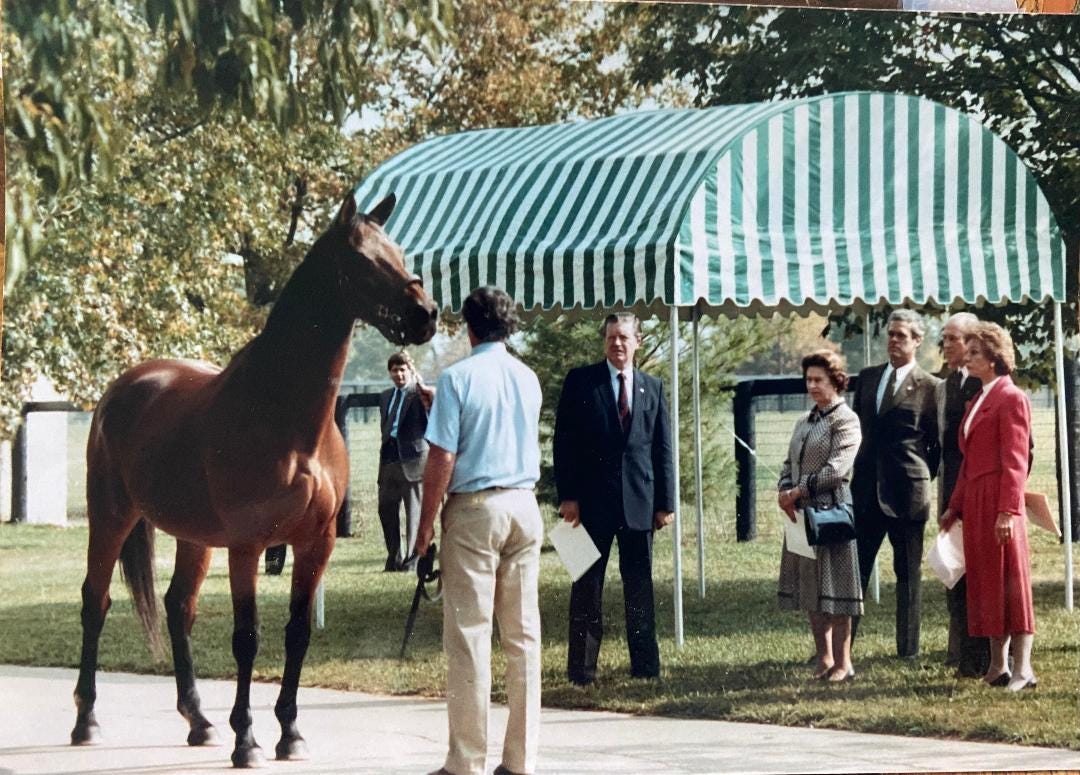
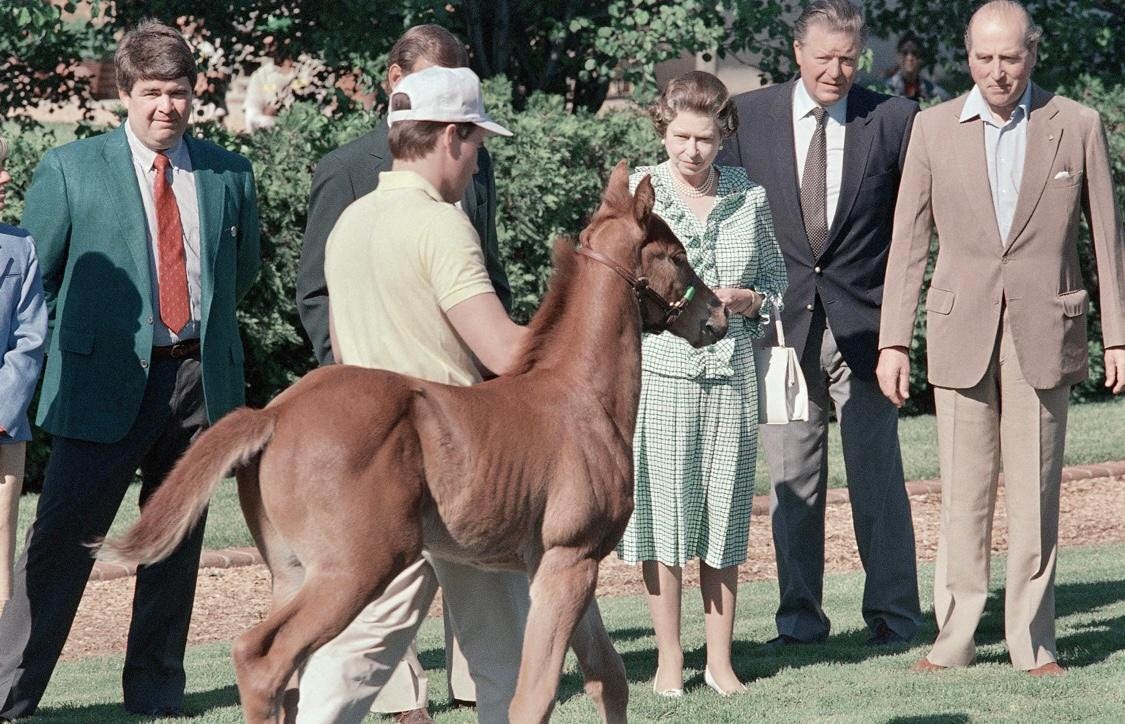
What a "gift" to read..... enjoy your grandchildren and I will enjoy your archive of articles!!!!
fascinating Sally!!!